Abstract
AIM: To determine the importance of tumour DNA ploidy and cell proliferation, as measured by the S phase fraction (SPF), in relation to other established clinicopathological indicators of prognosis in breast cancer. METHODS: A prospective study of 308 patients. Tumours were staged following the TNM system criteria and were classified according to the histological type and grade. DNA flow cytometry was performed on fresh/frozen samples stained with propidium iodide. Hormone receptors were analyzed by immunocytochemistry. A Cox proportional hazards regression model was used for statistical evaluation of the prognostic factors. RESULTS: Median follow up time was 39.6 months (range 3 to 84). A DNA diploid pattern was found in 134 tumours (43.5%) and aneuploid in 174 (56.5%). Median SPF value was 6.1% (range 1% to 27.8%). DNA ploidy and SPF were strongly correlated (p < 0.001), and both were related to histological type (p < 0.001), grade of differentiation (p < 0.001), tumour size (p = 0.006 and p = 0.002), and hormone receptor activity (p < 0.001). DNA ploidy was also related to node status (p = 0.022), but SPF was not. In univariate analysis, there were significant correlations between disease-free survival and age, histological grade, tumour size, node status, DNA ploidy, SPF, and hormone receptor activity; age, tumour size, node status, DNA ploidy, and hormone receptors were predictors of overall survival. In multivariate analysis, only node status (p = 0.001) and DNA ploidy (p = 0.006) retained independent prognostic significance in relation with overall survival, while node status (p < 0.001) and SPF (p < 0.001) were predictors of disease-free survival. DNA ploidy and SPF continued to predict disease-free and overall survival in lymph node positive (pN1) patients but not in the lymph node negative (pN0) group. CONCLUSIONS: DNA ploidy and SPF are strongly intercorrelated and have independent prognostic value for predicting the short term clinical outcome of breast carcinoma patients.
Full text
PDF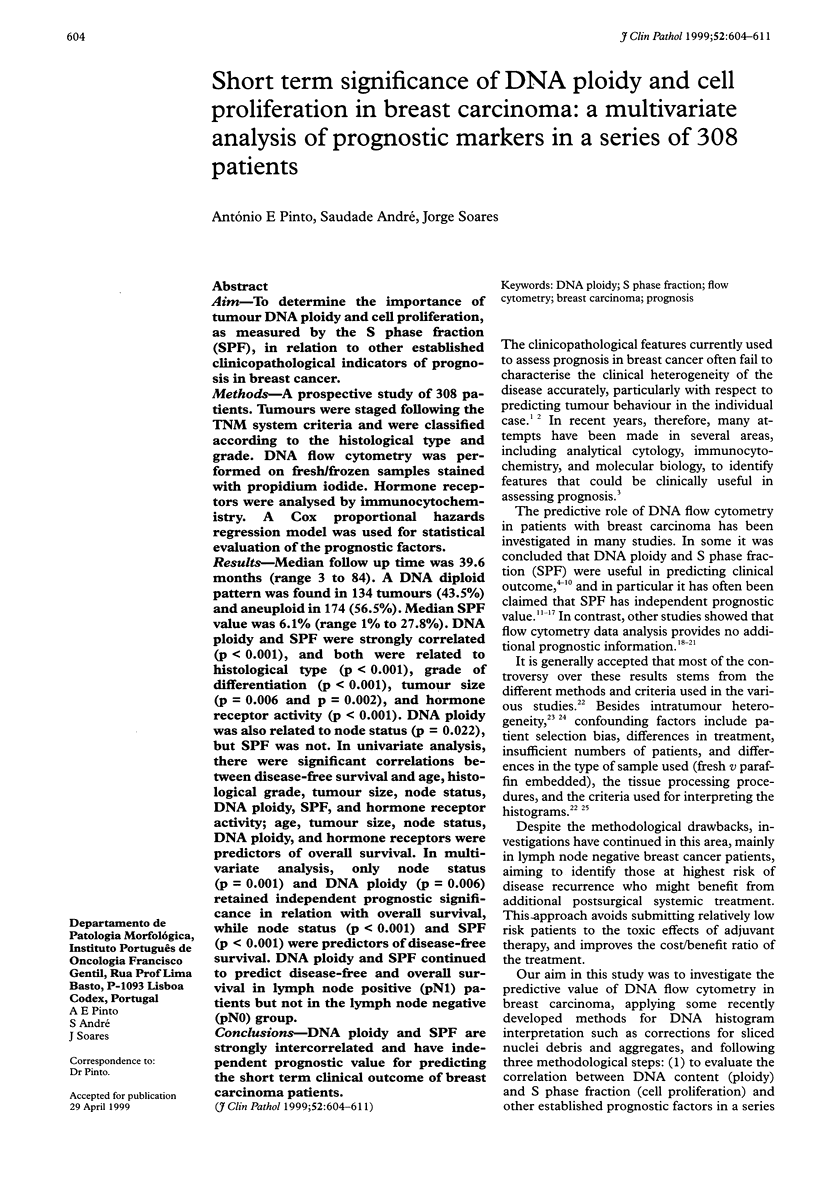
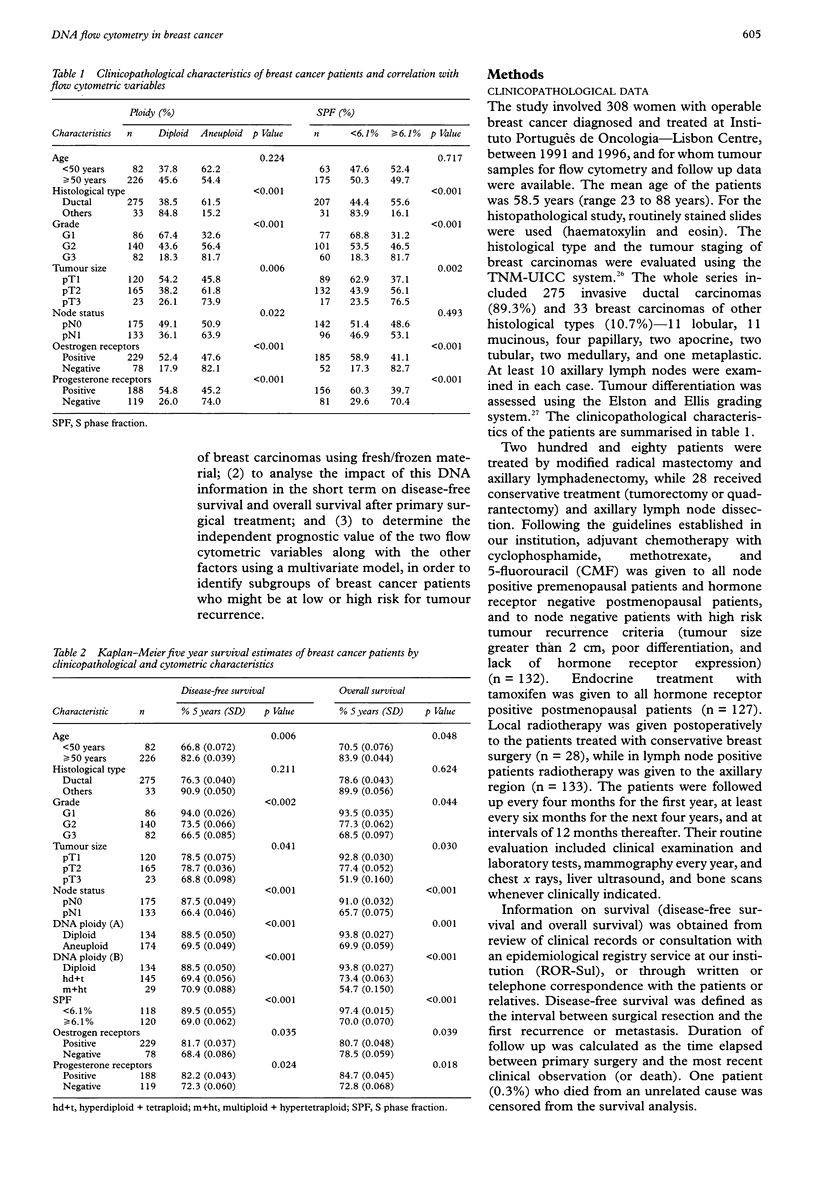
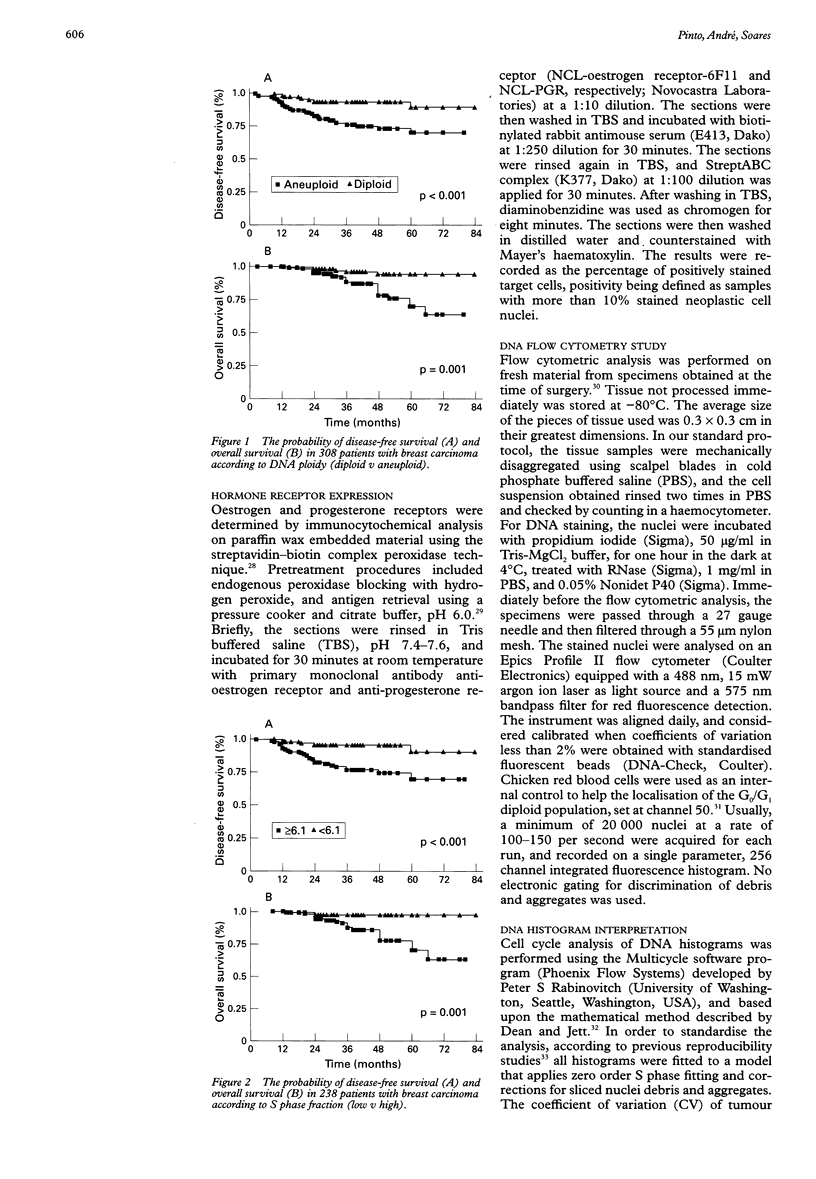
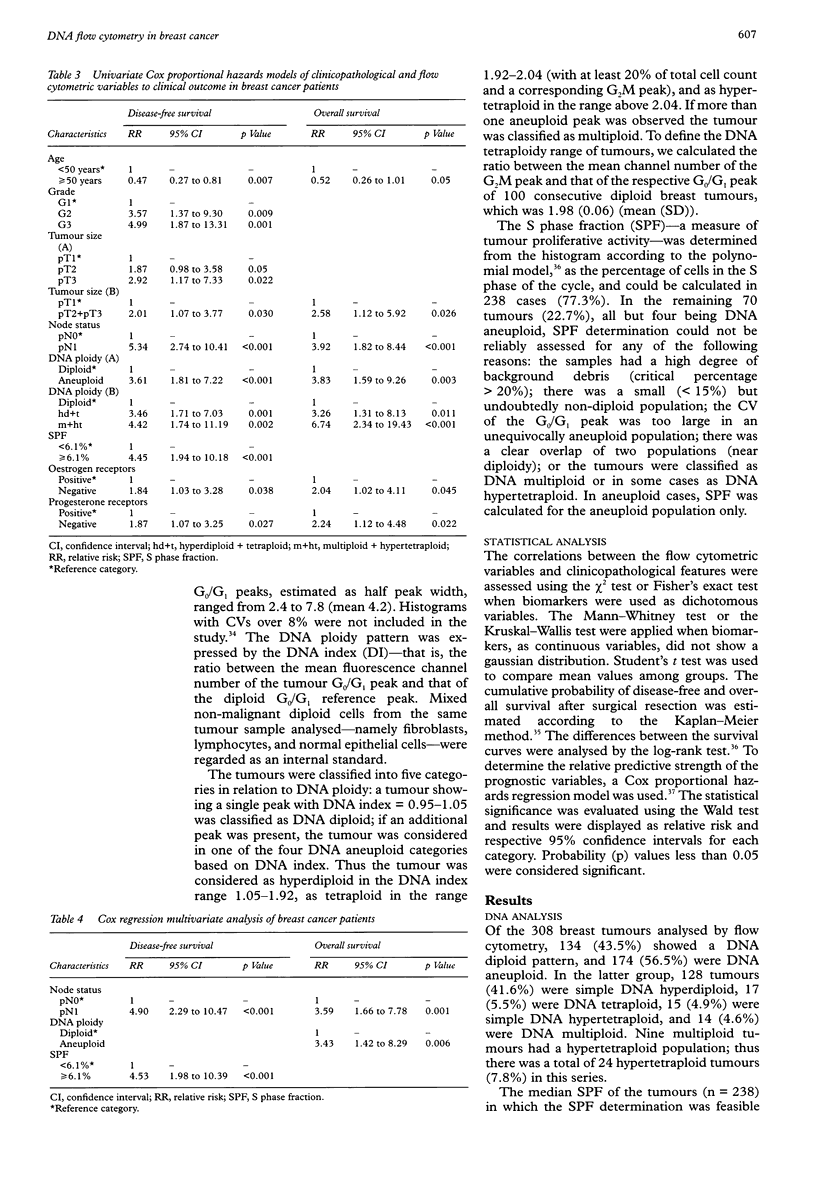
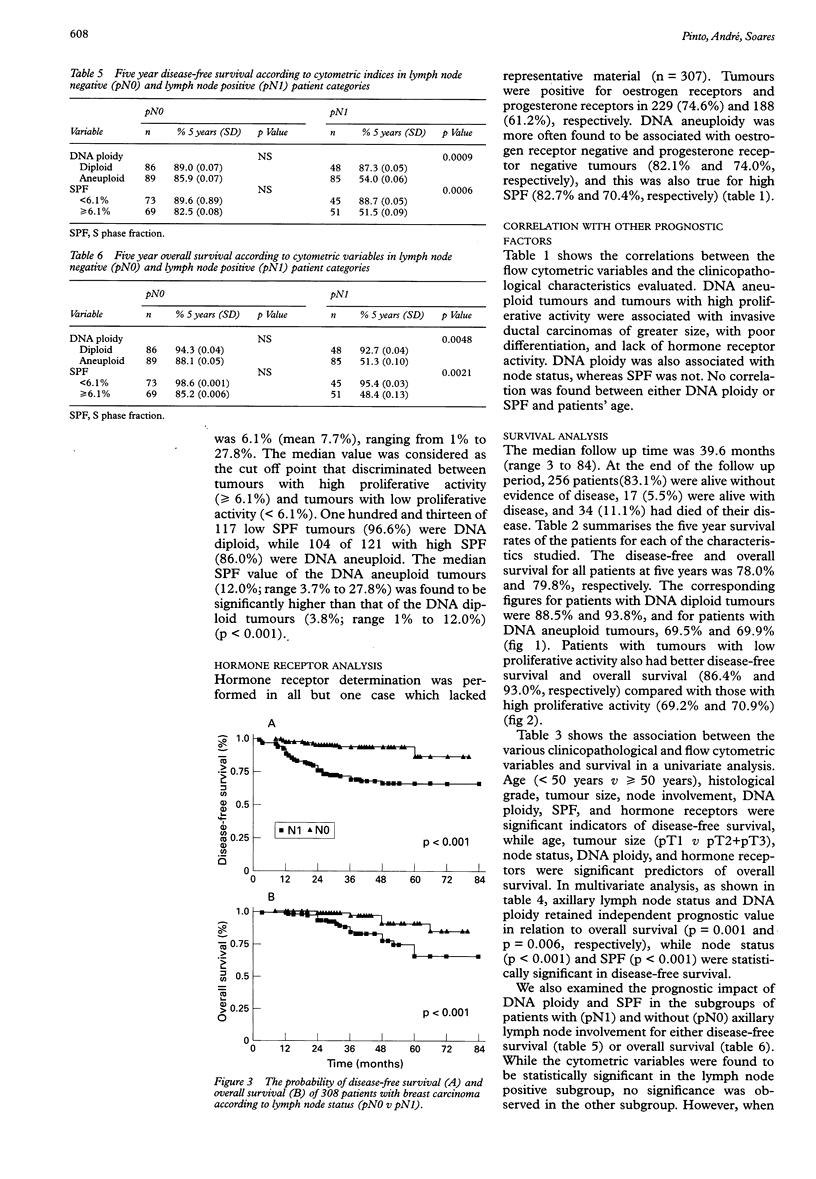
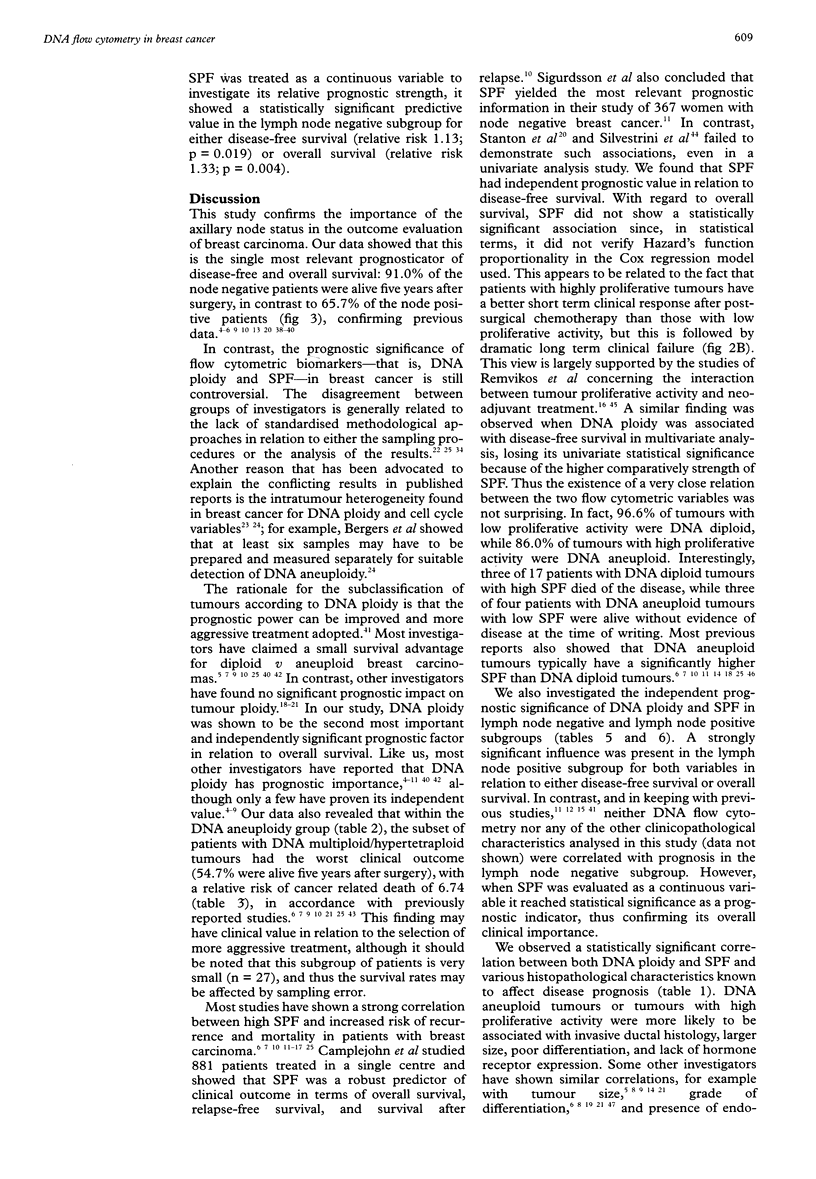
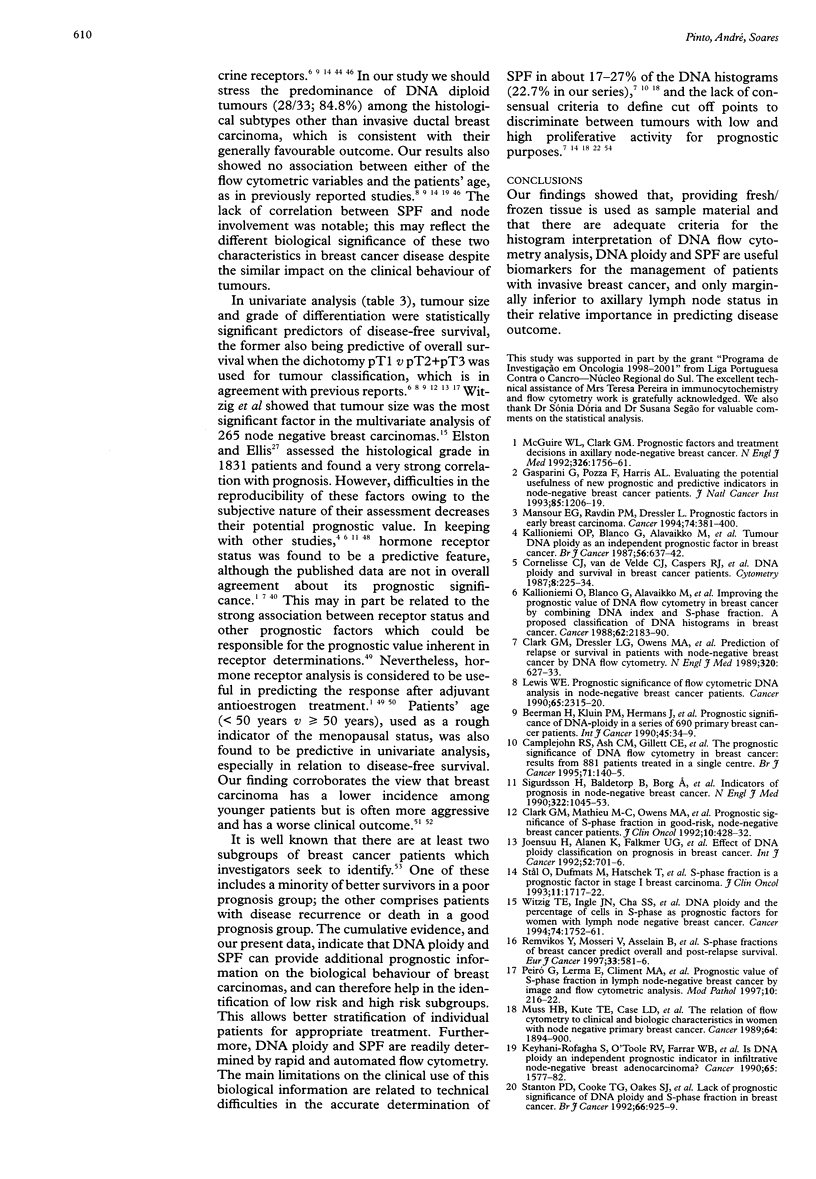
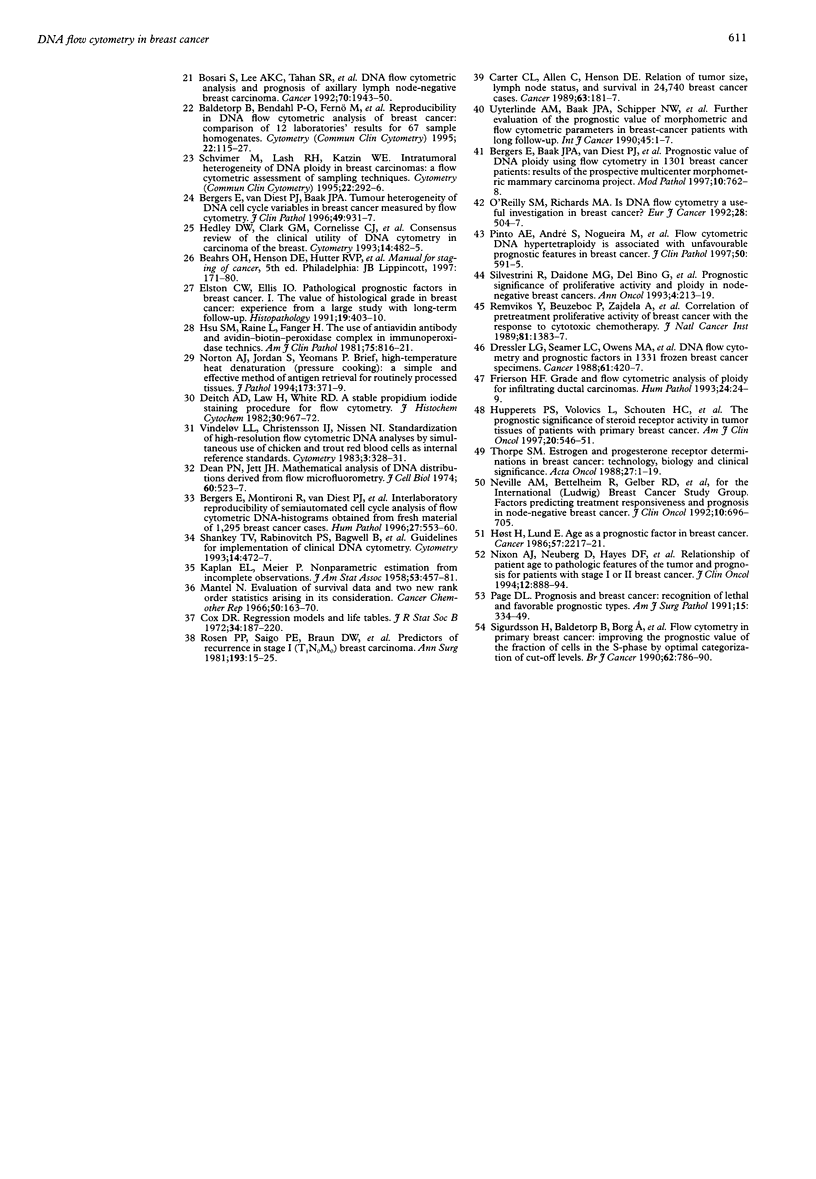
Selected References
These references are in PubMed. This may not be the complete list of references from this article.
- Baldetorp B., Bendahl P. O., Fernö M., Alanen K., Delle U., Falkmer U., Hansson-Aggesjö B., Höckenström T., Lindgren A., Mossberg L. Reproducibility in DNA flow cytometric analysis of breast cancer: comparison of 12 laboratories' results for 67 sample homogenates. Cytometry. 1995 Jun 15;22(2):115–127. doi: 10.1002/cyto.990220207. [DOI] [PubMed] [Google Scholar]
- Bergers E., Baak J. P., van Diest P. J., Willig A. J., Los J., Peterse J. L., Ruitenberg H. M., Schapers R. F., Somsen J. G., van Beek M. W. Prognostic value of DNA ploidy using flow cytometry in 1301 breast cancer patients: results of the prospective Multicenter Morphometric Mammary Carcinoma Project. Mod Pathol. 1997 Aug;10(8):762–768. [PubMed] [Google Scholar]
- Bergers E., Montironi R., van Diest P. J., Prete E., Baak J. P. Interlaboratory reproducibility of semiautomated cell cycle analysis of flow cytometry DNA-histograms obtained from fresh material of 1,295 breast cancer cases. Hum Pathol. 1996 Jun;27(6):553–560. doi: 10.1016/s0046-8177(96)90161-6. [DOI] [PubMed] [Google Scholar]
- Bergers E., van Diest P. J., Baak J. P. Tumour heterogeneity of DNA cell cycle variables in breast cancer measured by flow cytometry. J Clin Pathol. 1996 Nov;49(11):931–937. doi: 10.1136/jcp.49.11.931. [DOI] [PMC free article] [PubMed] [Google Scholar]
- Bosari S., Lee A. K., Tahan S. R., Figoni M. A., Wiley B. D., Heatley G. J., Silverman M. L. DNA flow cytometric analysis and prognosis of axillary lymph node-negative breast carcinoma. Cancer. 1992 Oct 1;70(7):1943–1950. doi: 10.1002/1097-0142(19921001)70:7<1943::aid-cncr2820700722>3.0.co;2-y. [DOI] [PubMed] [Google Scholar]
- Camplejohn R. S., Ash C. M., Gillett C. E., Raikundalia B., Barnes D. M., Gregory W. M., Richards M. A., Millis R. R. The prognostic significance of DNA flow cytometry in breast cancer: results from 881 patients treated in a single centre. Br J Cancer. 1995 Jan;71(1):140–145. doi: 10.1038/bjc.1995.29. [DOI] [PMC free article] [PubMed] [Google Scholar]
- Carter C. L., Allen C., Henson D. E. Relation of tumor size, lymph node status, and survival in 24,740 breast cancer cases. Cancer. 1989 Jan 1;63(1):181–187. doi: 10.1002/1097-0142(19890101)63:1<181::aid-cncr2820630129>3.0.co;2-h. [DOI] [PubMed] [Google Scholar]
- Clark G. M., Dressler L. G., Owens M. A., Pounds G., Oldaker T., McGuire W. L. Prediction of relapse or survival in patients with node-negative breast cancer by DNA flow cytometry. N Engl J Med. 1989 Mar 9;320(10):627–633. doi: 10.1056/NEJM198903093201003. [DOI] [PubMed] [Google Scholar]
- Clark G. M., Mathieu M. C., Owens M. A., Dressler L. G., Eudey L., Tormey D. C., Osborne C. K., Gilchrist K. W., Mansour E. G., Abeloff M. D. Prognostic significance of S-phase fraction in good-risk, node-negative breast cancer patients. J Clin Oncol. 1992 Mar;10(3):428–432. doi: 10.1200/JCO.1992.10.3.428. [DOI] [PubMed] [Google Scholar]
- Cornelisse C. J., van de Velde C. J., Caspers R. J., Moolenaar A. J., Hermans J. DNA ploidy and survival in breast cancer patients. Cytometry. 1987 Mar;8(2):225–234. doi: 10.1002/cyto.990080217. [DOI] [PubMed] [Google Scholar]
- Dean P. N., Jett J. H. Mathematical analysis of DNA distributions derived from flow microfluorometry. J Cell Biol. 1974 Feb;60(2):523–527. doi: 10.1083/jcb.60.2.523. [DOI] [PMC free article] [PubMed] [Google Scholar]
- Deitch A. D., Law H., deVere White R. A stable propidium iodide staining procedure for flow cytometry. J Histochem Cytochem. 1982 Sep;30(9):967–972. doi: 10.1177/30.9.6182188. [DOI] [PubMed] [Google Scholar]
- Dressler L. G., Seamer L. C., Owens M. A., Clark G. M., McGuire W. L. DNA flow cytometry and prognostic factors in 1331 frozen breast cancer specimens. Cancer. 1988 Feb 1;61(3):420–427. doi: 10.1002/1097-0142(19880201)61:3<420::aid-cncr2820610303>3.0.co;2-0. [DOI] [PubMed] [Google Scholar]
- Elston C. W., Ellis I. O. Pathological prognostic factors in breast cancer. I. The value of histological grade in breast cancer: experience from a large study with long-term follow-up. Histopathology. 1991 Nov;19(5):403–410. doi: 10.1111/j.1365-2559.1991.tb00229.x. [DOI] [PubMed] [Google Scholar]
- Frierson H. F., Jr Grade and flow cytometric analysis of ploidy for infiltrating ductal carcinomas. Hum Pathol. 1993 Jan;24(1):24–29. doi: 10.1016/0046-8177(93)90058-o. [DOI] [PubMed] [Google Scholar]
- Gasparini G., Pozza F., Harris A. L. Evaluating the potential usefulness of new prognostic and predictive indicators in node-negative breast cancer patients. J Natl Cancer Inst. 1993 Aug 4;85(15):1206–1219. doi: 10.1093/jnci/85.15.1206. [DOI] [PubMed] [Google Scholar]
- Hedley D. W., Clark G. M., Cornelisse C. J., Killander D., Kute T., Merkel D. Consensus review of the clinical utility of DNA cytometry in carcinoma of the breast. Report of the DNA Cytometry Consensus Conference. Cytometry. 1993;14(5):482–485. doi: 10.1002/cyto.990140505. [DOI] [PubMed] [Google Scholar]
- Hupperets P. S., Volovics L., Schouten L. J., Jager J. J., Schouten H. C., Hillen H. F., Blijham G. H. The prognostic significance of steroid receptor activity in tumor tissues of patients with primary breast cancer. Am J Clin Oncol. 1997 Dec;20(6):546–551. doi: 10.1097/00000421-199712000-00002. [DOI] [PubMed] [Google Scholar]
- Høst H., Lund E. Age as a prognostic factor in breast cancer. Cancer. 1986 Jun 1;57(11):2217–2221. doi: 10.1002/1097-0142(19860601)57:11<2217::aid-cncr2820571124>3.0.co;2-t. [DOI] [PubMed] [Google Scholar]
- Joensuu H., Alanen K., Falkmer U. G., Klemi P., Nordling S., Remvikos Y., Toikkanen S. Effect of DNA ploidy classification on prognosis in breast cancer. Int J Cancer. 1992 Nov 11;52(5):701–706. doi: 10.1002/ijc.2910520506. [DOI] [PubMed] [Google Scholar]
- Kallioniemi O. P., Blanco G., Alavaikko M., Hietanen T., Mattila J., Lauslahti K., Koivula T. Tumour DNA ploidy as an independent prognostic factor in breast cancer. Br J Cancer. 1987 Nov;56(5):637–642. doi: 10.1038/bjc.1987.258. [DOI] [PMC free article] [PubMed] [Google Scholar]
- Kallioniemi O. P., Blanco G., Alavaikko M., Hietanen T., Mattila J., Lauslahti K., Lehtinen M., Koivula T. Improving the prognostic value of DNA flow cytometry in breast cancer by combining DNA index and S-phase fraction. A proposed classification of DNA histograms in breast cancer. Cancer. 1988 Nov 15;62(10):2183–2190. doi: 10.1002/1097-0142(19881115)62:10<2183::aid-cncr2820621019>3.0.co;2-b. [DOI] [PubMed] [Google Scholar]
- Keyhani-Rofagha S., O'Toole R. V., Farrar W. B., Sickle-Santanello B., DeCenzo J., Young D. Is DNA ploidy an independent prognostic indicator in infiltrative node-negative breast adenocarcinoma? Cancer. 1990 Apr 1;65(7):1577–1582. doi: 10.1002/1097-0142(19900401)65:7<1577::aid-cncr2820650721>3.0.co;2-d. [DOI] [PubMed] [Google Scholar]
- Lewis W. E. Prognostic significance of flow cytometric DNA analysis in node-negative breast cancer patients. Cancer. 1990 May 15;65(10):2315–2320. doi: 10.1002/1097-0142(19900515)65:10<2315::aid-cncr2820651025>3.0.co;2-3. [DOI] [PubMed] [Google Scholar]
- Mansour E. G., Ravdin P. M., Dressler L. Prognostic factors in early breast carcinoma. Cancer. 1994 Jul 1;74(1 Suppl):381–400. doi: 10.1002/cncr.2820741326. [DOI] [PubMed] [Google Scholar]
- Mantel N. Evaluation of survival data and two new rank order statistics arising in its consideration. Cancer Chemother Rep. 1966 Mar;50(3):163–170. [PubMed] [Google Scholar]
- McGuire W. L., Clark G. M. Prognostic factors and treatment decisions in axillary-node-negative breast cancer. N Engl J Med. 1992 Jun 25;326(26):1756–1761. doi: 10.1056/NEJM199206253262607. [DOI] [PubMed] [Google Scholar]
- Muss H. B., Kute T. E., Case L. D., Smith L. R., Booher C., Long R., Kammire L., Gregory B., Brockschmidt J. K. The relation of flow cytometry to clinical and biologic characteristics in women with node negative primary breast cancer. Cancer. 1989 Nov 1;64(9):1894–1900. doi: 10.1002/1097-0142(19891101)64:9<1894::aid-cncr2820640923>3.0.co;2-k. [DOI] [PubMed] [Google Scholar]
- Neville A. M., Bettelheim R., Gelber R. D., Säve-Söderbergh J., Davis B. W., Reed R., Torhorst J., Golouh R., Peterson H. F., Price K. N. Factors predicting treatment responsiveness and prognosis in node-negative breast cancer. The International (Ludwig) Breast Cancer Study Group. J Clin Oncol. 1992 May;10(5):696–705. doi: 10.1200/JCO.1992.10.5.696. [DOI] [PubMed] [Google Scholar]
- Nixon A. J., Neuberg D., Hayes D. F., Gelman R., Connolly J. L., Schnitt S., Abner A., Recht A., Vicini F., Harris J. R. Relationship of patient age to pathologic features of the tumor and prognosis for patients with stage I or II breast cancer. J Clin Oncol. 1994 May;12(5):888–894. doi: 10.1200/JCO.1994.12.5.888. [DOI] [PubMed] [Google Scholar]
- Norton A. J., Jordan S., Yeomans P. Brief, high-temperature heat denaturation (pressure cooking): a simple and effective method of antigen retrieval for routinely processed tissues. J Pathol. 1994 Aug;173(4):371–379. doi: 10.1002/path.1711730413. [DOI] [PubMed] [Google Scholar]
- O'Reilly S. M., Richards M. A. Is DNA flow cytometry a useful investigation in breast cancer? Eur J Cancer. 1992;28(2-3):504–507. doi: 10.1016/s0959-8049(05)80088-7. [DOI] [PubMed] [Google Scholar]
- Page D. L. Prognosis and breast cancer. Recognition of lethal and favorable prognostic types. Am J Surg Pathol. 1991 Apr;15(4):334–349. doi: 10.1097/00000478-199104000-00002. [DOI] [PubMed] [Google Scholar]
- Peiró G., Lerma E., Climent M. A., Seguí M. A., Alonso M. C., Prat J. Prognostic value of S-phase fraction in lymph-node-negative breast cancer by image and flow cytometric analysis. Mod Pathol. 1997 Mar;10(3):216–222. [PubMed] [Google Scholar]
- Pinto A. E., André S., Nogueira M., Mendonça E., Soares J. Flow cytometric DNA hypertetraploidy is associated with unfavourable prognostic features in breast cancer. J Clin Pathol. 1997 Jul;50(7):591–595. doi: 10.1136/jcp.50.7.591. [DOI] [PMC free article] [PubMed] [Google Scholar]
- Remvikos Y., Beuzeboc P., Zajdela A., Voillemot N., Magdelénat H., Pouillart P. Correlation of pretreatment proliferative activity of breast cancer with the response to cytotoxic chemotherapy. J Natl Cancer Inst. 1989 Sep 20;81(18):1383–1387. doi: 10.1093/jnci/81.18.1383. [DOI] [PubMed] [Google Scholar]
- Remvikos Y., Mosseri V., Asselain B., Fourquet A., Durand J. C., Pouillart P., Magdelénat H. S-phase fractions of breast cancer predict overall and post-relapse survival. Eur J Cancer. 1997 Apr;33(4):581–586. doi: 10.1016/s0959-8049(96)00531-x. [DOI] [PubMed] [Google Scholar]
- Rosen P. P., Saigo P. E., Braun D. W., Jr, Weathers E., DePalo A. Predictors of recurrence in stage I (T1N0M0) breast carcinoma. Ann Surg. 1981 Jan;193(1):15–25. doi: 10.1097/00000658-198101000-00003. [DOI] [PMC free article] [PubMed] [Google Scholar]
- Schvimer M., Lash R. H., Katzin W. E. Intratumoral heterogeneity of DNA ploidy in breast carcinomas: a flow cytometric assessment of sampling techniques. Cytometry. 1995 Dec 15;22(4):292–296. doi: 10.1002/cyto.990220405. [DOI] [PubMed] [Google Scholar]
- Shankey T. V., Rabinovitch P. S., Bagwell B., Bauer K. D., Duque R. E., Hedley D. W., Mayall B. H., Wheeless L., Cox C. Guidelines for implementation of clinical DNA cytometry. International Society for Analytical Cytology. Cytometry. 1993;14(5):472–477. doi: 10.1002/cyto.990140503. [DOI] [PubMed] [Google Scholar]
- Sigurdsson H., Baldetorp B., Borg A., Dalberg M., Fernö M., Killander D., Olsson H. Indicators of prognosis in node-negative breast cancer. N Engl J Med. 1990 Apr 12;322(15):1045–1053. doi: 10.1056/NEJM199004123221505. [DOI] [PubMed] [Google Scholar]
- Sigurdsson H., Baldetorp B., Borg A., Dalberg M., Fernö M., Killander D., Olsson H., Ranstam J. Flow cytometry in primary breast cancer: improving the prognostic value of the fraction of cells in the S-phase by optimal categorisation of cut-off levels. Br J Cancer. 1990 Nov;62(5):786–790. doi: 10.1038/bjc.1990.380. [DOI] [PMC free article] [PubMed] [Google Scholar]
- Silvestrini R., Daidone M. G., Del Bino G., Mastore M., Luisi A., Di Fronzo G., Boracchi P. Prognostic significance of proliferative activity and ploidy in node-negative breast cancers. Ann Oncol. 1993 Mar;4(3):213–219. doi: 10.1093/oxfordjournals.annonc.a058458. [DOI] [PubMed] [Google Scholar]
- Stanton P. D., Cooke T. G., Oakes S. J., Winstanley J., Holt S., George W. D., Murray G. D. Lack of prognostic significance of DNA ploidy and S phase fraction in breast cancer. Br J Cancer. 1992 Nov;66(5):925–929. doi: 10.1038/bjc.1992.387. [DOI] [PMC free article] [PubMed] [Google Scholar]
- Stål O., Dufmats M., Hatschek T., Carstensen J., Klintenberg C., Rutqvist L. E., Skoog L., Sullivan S., Wingren S., Nordenskjöld B. S-phase fraction is a prognostic factor in stage I breast carcinoma. J Clin Oncol. 1993 Sep;11(9):1717–1722. doi: 10.1200/JCO.1993.11.9.1717. [DOI] [PubMed] [Google Scholar]
- Thorpe S. M. Estrogen and progesterone receptor determinations in breast cancer. Technology, biology and clinical significance. Acta Oncol. 1988;27(1):1–19. doi: 10.3109/02841868809090312. [DOI] [PubMed] [Google Scholar]
- Vindeløv L. L., Christensen I. J., Nissen N. I. Standardization of high-resolution flow cytometric DNA analysis by the simultaneous use of chicken and trout red blood cells as internal reference standards. Cytometry. 1983 Mar;3(5):328–331. doi: 10.1002/cyto.990030504. [DOI] [PubMed] [Google Scholar]
- Witzig T. E., Ingle J. N., Cha S. S., Schaid D. J., Tabery R. L., Wold L. E., Grant C., Gonchoroff N. J., Katzmann J. A. DNA ploidy and the percentage of cells in S-phase as prognostic factors for women with lymph node negative breast cancer. Cancer. 1994 Sep 15;74(6):1752–1761. doi: 10.1002/1097-0142(19940915)74:6<1752::aid-cncr2820740618>3.0.co;2-5. [DOI] [PubMed] [Google Scholar]


